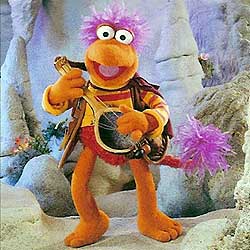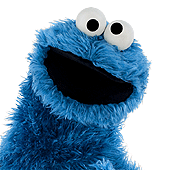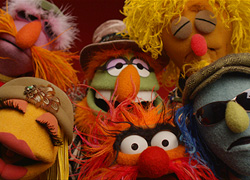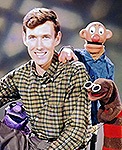-
 Welcome to the Muppet Central Forum!
Welcome to the Muppet Central Forum!
You are viewing our forum as a guest. Join our free community to post topics and start private conversations. Please contact us if you need help. -
 Back to the Rock Season 2
Back to the Rock Season 2
Fraggle Rock Back to the Rock Season 2 has premiered on AppleTV+. Watch the anticipated new season and let us know your thoughts. -
 Sesame Street Season 54
Sesame Street Season 54
Sesame Street Season 54 has premiered on Max with new episodes each Thursday. Watch and let us know your thoughts. -
 The Muppets Mayhem premieres
The Muppets Mayhem premieres
The series debut of the year is here! Let us know your thoughts and reviews of The Muppets Mayhem now streaming on Disney+. -
 Bear arrives on Disney+
Bear arrives on Disney+
The beloved series has been off the air for the past 15 years. Now all four seasons are finally available for a whole new generation. -
 Sam and Friends Book
Sam and Friends Book
Read our review of the long-awaited book, "Sam and Friends - The Story of Jim Henson's First Television Show" by Muppet Historian Craig Shemin.
Coloring Comic Strips Digitally?
- Thread starter D'Snowth
- Start date
anythingmuppet
Well-Known Member
- Joined
- Aug 24, 2005
- Messages
- 1,547
- Reaction score
- 4
Yeah, what you do is scan your comic and go to Photoshop and color it. I think you have to select which parts are going to be which color.
Vic Romano
Well-Known Member
- Joined
- Nov 17, 2003
- Messages
- 5,161
- Reaction score
- 86
Usually a scanner is involved, yes. There are so many different mediums. Generally, I do my pencil sketch and then ink them using either a quill pen or Micron Pigma markers (thanks Jay!  )... OR I'll scan the pencil sketch into the computer and using a Walcom tablet; I'll "ink" it in Adobe Illustrator. Minidoozer here on MC is a GENIUS with a Walcom tablet, you should see the almost photo-real pictures she does (Wait'll you see her contribution to the FanArtist's visual!). Then coloring is generally done in Adobe Photoshop, but there are other programs as well (Paintshop Pro is another one), but PS is the industry standard.
)... OR I'll scan the pencil sketch into the computer and using a Walcom tablet; I'll "ink" it in Adobe Illustrator. Minidoozer here on MC is a GENIUS with a Walcom tablet, you should see the almost photo-real pictures she does (Wait'll you see her contribution to the FanArtist's visual!). Then coloring is generally done in Adobe Photoshop, but there are other programs as well (Paintshop Pro is another one), but PS is the industry standard.
Most comic books are digitally colored nowadays, I'd be willing to say that I believe it was Image comics who really were the trailblazers for that. Some people do everything on the computer now, sketching included. Check out this awesome tutorial I found on Deviant Art, completly drawn, inked and colored in Painter 7.
 )... OR I'll scan the pencil sketch into the computer and using a Walcom tablet; I'll "ink" it in Adobe Illustrator. Minidoozer here on MC is a GENIUS with a Walcom tablet, you should see the almost photo-real pictures she does (Wait'll you see her contribution to the FanArtist's visual!). Then coloring is generally done in Adobe Photoshop, but there are other programs as well (Paintshop Pro is another one), but PS is the industry standard.
)... OR I'll scan the pencil sketch into the computer and using a Walcom tablet; I'll "ink" it in Adobe Illustrator. Minidoozer here on MC is a GENIUS with a Walcom tablet, you should see the almost photo-real pictures she does (Wait'll you see her contribution to the FanArtist's visual!). Then coloring is generally done in Adobe Photoshop, but there are other programs as well (Paintshop Pro is another one), but PS is the industry standard.Most comic books are digitally colored nowadays, I'd be willing to say that I believe it was Image comics who really were the trailblazers for that. Some people do everything on the computer now, sketching included. Check out this awesome tutorial I found on Deviant Art, completly drawn, inked and colored in Painter 7.
Darn! Why most everything revolve around a scanner!? I desperately need a scanner for more reasons than one. Maybe with the new season of my personal comic strip series comes up, I MIGHT try digital colorization.
Would Macromedia Fireworks work as well, that's what I got.
Would Macromedia Fireworks work as well, that's what I got.
Vic Romano
Well-Known Member
- Joined
- Nov 17, 2003
- Messages
- 5,161
- Reaction score
- 86
Fireworks is Macromedia's version of Adobe Illustrator. They're what you call Vector Art programs. A basic definition might go like this:
You see, bitmapped images like jpegs, pngs, gifs, bmps etc; are made up of hundreds and thousands of dots called pixels. Depending on the ratio of pixels per inch depends on the quality of the image. For example; you can have a picture that's 8" x 10" inches at 72 dots (pixels) per inch and that's fine for posting on the web; 72dpi is standard web resolution. But if you want that picture to print nicely, you have to resize that image to 300 dpi, and that dramatically shrinks the size of the picture from 8" x 10" to roughly 2" x 1"! 300 dpi is standard print resolution.
Basically what that means, is that whether you shrink or especially blow up a bitmapped image, you are throwing away data about that image and losing image quality, that's why jpegs look so bad when you zoom in or blow them up. Generally; a bitmapped image can be increased in size by only about 30% before you start to notice loss of image quality. This is why digital cameras also are constantly pushing for a higher mega pixel. The image isn't necessarily better quality; it's just taken at a much larger physical size, so that when it's dpi is changed for print; the picture may be shrunken dramatically, only now instead of going from an 8x10 to a 1x2; it's going from 48" x 60" to 11" x 14" and the image can be printed at that size and look really good because it's starting off with a much larger image to begin with.
Now Vector art is created by algorithms that allow the image to be manipulated anyway and never lose their mathmatical proportions. So if you draw an image in say Fireworks, Illustrator or even Flash; you can shrink or enlarge the image as much as you want without losing the quality of it. These are basic rules of graphic design, but it's also why most of my visuals can't be enlarged much larger then what they already are, because they're created using web graphics and thusly I have to work at a low resolution, this makes it rather tricky to create good looking art for the web sometimes.
You see, bitmapped images like jpegs, pngs, gifs, bmps etc; are made up of hundreds and thousands of dots called pixels. Depending on the ratio of pixels per inch depends on the quality of the image. For example; you can have a picture that's 8" x 10" inches at 72 dots (pixels) per inch and that's fine for posting on the web; 72dpi is standard web resolution. But if you want that picture to print nicely, you have to resize that image to 300 dpi, and that dramatically shrinks the size of the picture from 8" x 10" to roughly 2" x 1"! 300 dpi is standard print resolution.
Basically what that means, is that whether you shrink or especially blow up a bitmapped image, you are throwing away data about that image and losing image quality, that's why jpegs look so bad when you zoom in or blow them up. Generally; a bitmapped image can be increased in size by only about 30% before you start to notice loss of image quality. This is why digital cameras also are constantly pushing for a higher mega pixel. The image isn't necessarily better quality; it's just taken at a much larger physical size, so that when it's dpi is changed for print; the picture may be shrunken dramatically, only now instead of going from an 8x10 to a 1x2; it's going from 48" x 60" to 11" x 14" and the image can be printed at that size and look really good because it's starting off with a much larger image to begin with.
Now Vector art is created by algorithms that allow the image to be manipulated anyway and never lose their mathmatical proportions. So if you draw an image in say Fireworks, Illustrator or even Flash; you can shrink or enlarge the image as much as you want without losing the quality of it. These are basic rules of graphic design, but it's also why most of my visuals can't be enlarged much larger then what they already are, because they're created using web graphics and thusly I have to work at a low resolution, this makes it rather tricky to create good looking art for the web sometimes.
Vic Romano
Well-Known Member
- Joined
- Nov 17, 2003
- Messages
- 5,161
- Reaction score
- 86
Here's a little somethin' I did awhile back for a workbook cover that covers the stages from concept to finished product via digital coloring.
The Sketch
Not much to it; just the standard begining and in this case, no computer, just a #2 pencil and a sketch pad.
Computer Inking
I scanned my sketch into the computer, but only at 72dpi because I only needed a low res image to trace in Adobe Illustrator. This outline became vector art, so I was able to manipulate the size there after with no worries. I then imported this outline into Photoshop where it became bitmapped, yes; but the outline is VERY crisp and neat. You can also see changes happen that were made during meetings with the editor.
Base Color
Now using the magic of layers in PS, I colored the robot with simple base colors. The outline remains on the top and the various color layers fall beneath it.
Final Rendering
Once again using more layers and adjusting their properties on how they react with layers below them; the shading and highlights are added. Now I just hand the final artwork over to the designer who uses it as needed, in this case it was placed on the cover of a work book for students.
The Sketch
Not much to it; just the standard begining and in this case, no computer, just a #2 pencil and a sketch pad.
Computer Inking
I scanned my sketch into the computer, but only at 72dpi because I only needed a low res image to trace in Adobe Illustrator. This outline became vector art, so I was able to manipulate the size there after with no worries. I then imported this outline into Photoshop where it became bitmapped, yes; but the outline is VERY crisp and neat. You can also see changes happen that were made during meetings with the editor.
Base Color
Now using the magic of layers in PS, I colored the robot with simple base colors. The outline remains on the top and the various color layers fall beneath it.
Final Rendering
Once again using more layers and adjusting their properties on how they react with layers below them; the shading and highlights are added. Now I just hand the final artwork over to the designer who uses it as needed, in this case it was placed on the cover of a work book for students.
Beauregard
Well-Known Member
- Joined
- Apr 16, 2002
- Messages
- 19,240
- Reaction score
- 1,239
*stares at screen for the best part of quater of an hour* That guy got a name?
Ah, so that's how it works! I know a guy who does alot of his latest online comic strips that way.Vic Romano said:Here's a little somethin' I did awhile back for a workbook cover that covers the stages from concept to finished product via digital coloring.
The Sketch
Not much to it; just the standard begining and in this case, no computer, just a #2 pencil and a sketch pad.
Computer Inking
I scanned my sketch into the computer, but only at 72dpi because I only needed a low res image to trace in Adobe Illustrator. This outline became vector art, so I was able to manipulate the size there after with no worries. I then imported this outline into Photoshop where it became bitmapped, yes; but the outline is VERY crisp and neat. You can also see changes happen that were made during meetings with the editor.
Base Color
Now using the magic of layers in PS, I colored the robot with simple base colors. The outline remains on the top and the various color layers fall beneath it.
Final Rendering
Once again using more layers and adjusting their properties on how they react with layers below them; the shading and highlights are added. Now I just hand the final artwork over to the designer who uses it as needed, in this case it was placed on the cover of a work book for students.
Limb
New Member
- Joined
- Nov 14, 2005
- Messages
- 4
- Reaction score
- 0
Wow, Vic- nice illutration!
There's a great book on coloring called 'How To Color And Letter DC Comics' (or close to that title). They have others on writing, inking, penciling, etc. I use their method to color http://www.BushiTales.com in Photoshop. It's a good way to do it, and can be used for any style of comics pretty much. I got my copy of it at the local comic shop, but I'm sure most big book stores carry them. It's around $20.
If you're going to color comics on the computer you really need a Wacom tablet and a scanner. They really aren't that much. I've got a 5"x4" or so Wacom at home, and a 9"x6" tablet at work. Any bigger is kind of much for my work space- and wallet. Do a search for Wacom or Intous (that's the style I have) and do some price shopping. A scanner can be picked up just about anywhere for under $100.
I also use CorelDraw, Freehand, and Illustrator for doing cartoons and other illustrations. I like vector art for my cartoons and logos. It's easy to alter and clean up. I did that for a comic strip for a loca radio station's website. I started to build up a clip art file that I could use and alter to save time.
Also, from time to time I'll scan in my partner Dave's pencils and then paint on top of/under them in layers using Photoshop. I'll do flat colors first, then go in and render them with the painting tools. The cover to the first BT comic and soundtrack were done that way.
Lin
There's a great book on coloring called 'How To Color And Letter DC Comics' (or close to that title). They have others on writing, inking, penciling, etc. I use their method to color http://www.BushiTales.com in Photoshop. It's a good way to do it, and can be used for any style of comics pretty much. I got my copy of it at the local comic shop, but I'm sure most big book stores carry them. It's around $20.
If you're going to color comics on the computer you really need a Wacom tablet and a scanner. They really aren't that much. I've got a 5"x4" or so Wacom at home, and a 9"x6" tablet at work. Any bigger is kind of much for my work space- and wallet. Do a search for Wacom or Intous (that's the style I have) and do some price shopping. A scanner can be picked up just about anywhere for under $100.
I also use CorelDraw, Freehand, and Illustrator for doing cartoons and other illustrations. I like vector art for my cartoons and logos. It's easy to alter and clean up. I did that for a comic strip for a loca radio station's website. I started to build up a clip art file that I could use and alter to save time.
Also, from time to time I'll scan in my partner Dave's pencils and then paint on top of/under them in layers using Photoshop. I'll do flat colors first, then go in and render them with the painting tools. The cover to the first BT comic and soundtrack were done that way.
Lin
